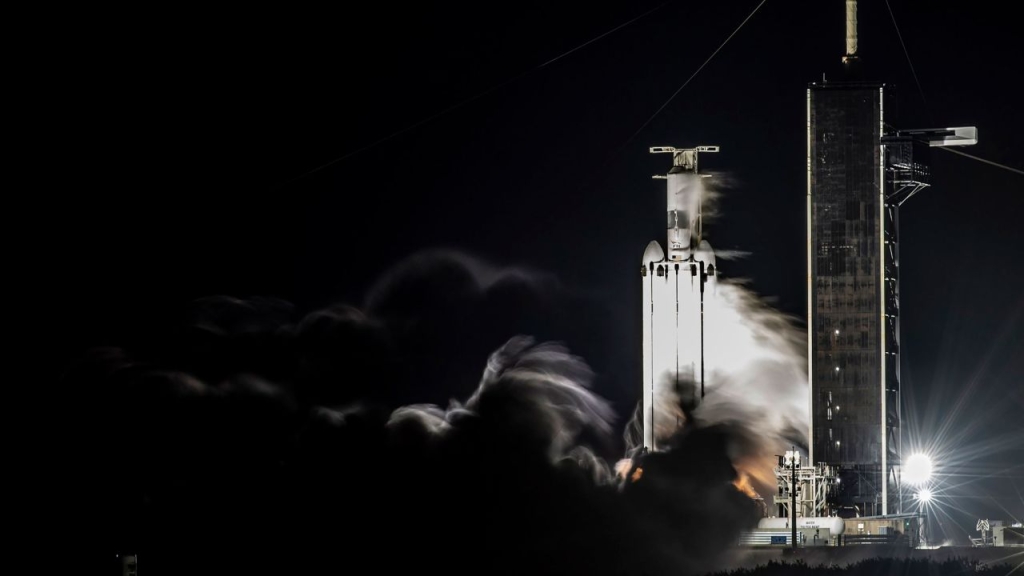() — SpaceX’s Falcon Heavy, an imposing three-pronged vehicle that is the world’s most powerful operational rocket, took to the skies again Tuesday for the first time since mid-2019.
The rocket was launched at 9:41 a.m. ET from NASA’s Kennedy Space Center in Florida, ferrying satellites into space for the US military on a secret mission dubbed USSF-44.
The Falcon Heavy debuted in 2018 to much fanfare, as SpaceX CEO Elon Musk chose to launch his personal Tesla Roadster as a test payload at launch. The car is still in space, taking an oblong path around the sun that swings to the orbital path of Mars.
Since that first test mission, SpaceX has only launched two other Falcon Heavy missions, both in 2019. One of them sent a huge TV and phone services satellite into orbit for Saudi Arabia-based Arabsat, and the other delivered a batch of experimental satellites for the United States Department of Defense.
But the rocket hadn’t launched since 2019, as the vast majority of SpaceX missions don’t require the amplified power of the Falcon Heavy. Instead, SpaceX’s workhorse Falcon 9 rocket has launched nearly 50 missions so far this year alone.
The Falcon Heavy rocket during a ground test at its launch site in Florida in October. (Photo: SpaceX/Twitter)
With each launch of the Falcon Heavy, the rocket puts on an extraordinary show on Earth.
SpaceX has attempted to land the rocket’s three boosters — the tall white tips that come together to give the rocket its greatest power at liftoff — on landing pads on land and at sea so they can be refurbished and reused on future missions. This is done to reduce the costs of the missions.
SpaceX has yet to land and recover all three booster rockets after the same mission, although it has come very close to doing so. The two side boosters made a precise and synchronized landing on land platforms after an April 2019 mission, and the rocket’s center booster landed on a sea platform. But then the strong waves of the sea knocked him down.
After Tuesday’s mission, the company only tried to recover two of the propellants of the first stage of the Falcon Heavy rocket. The center booster was dropped into the ocean, where it will remain discarded, because it did not have enough fuel left over to guide its journey home. according to a press release of the US Army Space Systems Command.
The side boosters, however, made their characteristic synchronized landing on land platforms near the Florida coast.
all about this rocket
Although the Falcon Heavy is the most powerful operational rocket in the world, there are two huge rockets that are hoping for to claim that title.
NASA’s Space Launch System (SLS) rocket, scheduled for its maiden launch in late November to send the uncrewed Artemis 1 mission around the Moon, sits in the Space Center’s imposing Vehicle Assembly Building Kennedy, located a few kilometers from the launch pad where the Falcon Heavy will take off.
While the Falcon Heavy puts out some 5 million pounds of thrust, the SLS is expected to put out up to 8.8 million pounds of thrust15% more thrust than the Saturn V rockets that powered the moon landings in the mid-20th century.
And just across the Gulf Coast, at SpaceX’s experimental facility in south Texas, the company is in the final stages of preparation for the first orbital launch attempt for its Starship spacecraft and Super Heavy rocket. Although the test flight is still pending final approval from federal regulators, it could take off before the end of the year.
The Starship system is expected to outpower both the SLS and the Falcon Heavy by a wide margin. The next Super Heavy rocket, designed to launch the Starship spacecraft into space, is expected to have a thrust of about 17 million pounds.
Both the SLS rocket and SpaceX’s Starship are part of NASA’s plans to return astronauts to the surface of the Moon for the first time in half a century.
SpaceX also has its own ambitious vision for the Starship: ferrying humans and cargo to Mars in hopes of one day establishing a permanent human settlement there.
All about this mission
There is not much information publicly available about the USSF-44 mission. In a press release, the U.S. Army Space Systems Command said only that the launch will put multiple satellites into orbit on behalf of Space Systems Command’s Innovation and Prototyping Delta, which is focused on the rapid development of space technology in in regards to tracking objects in space, as well as in a number of other activities.
Space Systems Command declined to provide further information about the mission when contacted by email. He referred questions to the Office of the Secretary of the Air Force, which also declined to comment.
The US military is one of the main drivers of the nation’s rocket economy, doling out lucrative launch contracts that are coveted by private launch companies, including SpaceX and its main competitor in the areaUnited Launch Alliance, which is a joint operation between Boeing and Lockheed Martin.










![[Img #74662]](https://thelatestnews.world/wp-content/uploads/2024/12/Organisms-with-the-shortest-life-150x150.jpg)



![[Img #74662]](https://thelatestnews.world/wp-content/uploads/2024/12/Organisms-with-the-shortest-life-300x200.jpg)
